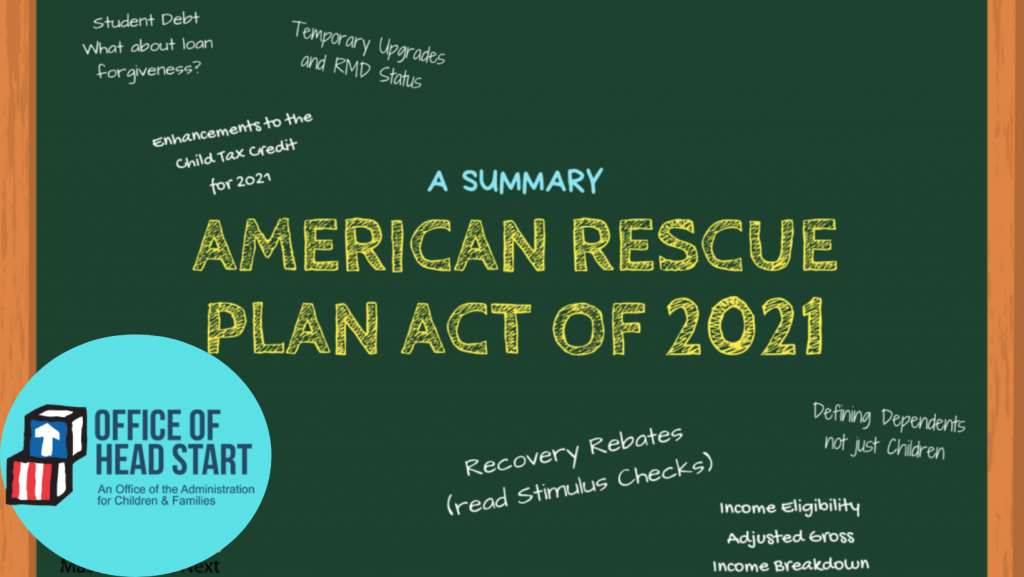
The American Rescue Plan (ARP) provides many sources of direct and indirect financial relief for low-income families. These payments and tax credits do not affect family income in determining eligibility for Head Start and Early Head Start programs or count towards adjusted gross income for tax filers. Encourage families to file 2020 taxes to receive available credits. (Source: Office of Head Start)
- Learn more about understanding and accessing available tax credits: EITCOutreach.org
- Free tax preparation services may be available for eligible families at Volunteer Income Tax Assistance (VITA) sites in your area.
Stimulus Checks
- Single adults earning up to $75,000 and head-of-household filers (e.g., single parents with children) earning up to $112,500 will receive a one-time payment of $1,400, plus $1,400 for each qualifying dependent.
- Married couples earning up to $150,000 will receive a one-time payment of $2,800, plus $1,400 for each qualifying dependent.
- This round of payments includes dependents who are included on the filer’s tax return but were excluded from previous stimulus payments: college students and adult dependents.
- For example, a single mother with two children claimed on her tax return should receive $4,200.
What can families do? Track the status of payments using the Internal Revenue Service’s (IRS) Get My Payment tool. If a family didn’t get a first or second stimulus payment or got less than the full amounts, they may be eligible to claim the Recovery Rebate Credit and must file a 2020 tax return even if they don’t usually file. Payments will be included in 2020 refunds.
Unemployment Benefits
- The first $10,200 of unemployment benefit payments received in 2020 are no longer taxable.
- For families currently receiving unemployment payments, there is a $300/week federal increase in payments until Sept. 6, 2021.
- The ARP also extends the special pandemic Unemployment Insurance (UI) program for people who do not usually qualify for UI (e.g., self-employed and gig workers) through Sept. 6, 2021.
What can families do? Families who received unemployment benefits in 2020 and already filed a 2020 tax return should file an amendment to receive money owed. Families who are not receiving UI but may be eligible can find information about eligibility and filing through their state unemployment office.
Monthly Child Allowance
- The ARP created a monthly child allowance to replace the current Child Tax Credit. Beginning in July 2021, families who are eligible for the ARP stimulus check will receive monthly payments of $300 per child under age 6 and $250 per child aged 6–17.
- This one-year program will end on Dec. 31, 2021.
- Individual Taxpayer Income Number (ITIN ) holders, including immigrant families with children born in the U.S with a social security number, are eligible to receive this credit.
What can families do? Families should start receiving monthly payments in July. The payment amount is based on the number of children claimed as dependents on a family’s most recent tax return (2019 or 2020). To ensure they receive the monthly payments starting in July, families should file a 2020 tax return by May 17, 2021. Families will retroactively claim this allowance from January–June 2020 on 2021 tax returns.
Child Care Expenses
- The ARP expands the size of the Child and Dependent Care Credit. Parents are eligible for this tax credit if they needed care for any child under age 13 or a disabled dependent of any age while working or looking for work.
- This includes any amount paid (full or co-pay) for center-based child care, babysitter care, summer camp, or care by adult relatives outside of the tax household.
- ITIN holders, including immigrant families with children born in the U.S with a social security number, are eligible to receive this credit.
What can families do? Families should keep records of their child care expenses to report on their 2021 tax returns. Even those who do not owe taxes should file because the credit will be fully refundable.
Food and Nutrition
- The ARP extends the current 15% Supplemental Nutrition Assistance Program (SNAP) increase until Sept. 30, 2021.
- States can choose to increase Women, Infants, and Children (WIC) benefits for four months, specifically to provide more fruits and vegetables to mothers and children.
- Through at least the summer, Pandemic-Electronic Benefits Transfer (P-EBT) assistance is extended. Like SNAP benefits, P-EBT can be used to replace the free or reduce price meals children miss when they do not attend school or child care in person.
What can families do? Families who are already enrolled in SNAP and WIC do not need to do anything. Most changes keep benefits at their current levels, and any adjustments will be automatic. Newly eligible families can enroll via their local SNAP or WIC office. Participating states will issue their own guidance for summer 2021 P-EBT.
Rental Assistance
- The ARP extends the eviction moratorium and makes more funding available for more people with overdue rent. Families are now eligible for renter’s assistance if at least one person in the household meets any of these criteria:
- Qualifies for unemployment
- Has had a decrease in income
- Has experienced some kind of financial hardship because of the COVID-19 pandemic
- Families can also qualify if they are at risk of experiencing homeless or if household income is at or below 80% of the median income for the area.
What can families do? Families who owe rent should contact their landlord about applying for assistance. A renter or a landlord can apply for assistance and the money is paid directly to the landlord or utility on the renter’s behalf. Find more information in this fact sheet and on the Consumer Financial Protection Bureau website. In addition, as of April 1, 2021, there is a temporary U.S. Centers for Disease Control and Prevention (CDC) eviction protection declaration. This is a temporary halt in residential evictions to prevent the further spread of COVID-19.